Interesting and informative: the upper stage “Breeze-M”

A good reaction to the first post about the space simulator Orbiter and at least two hundred people who became interested and downloaded add-ons to it, led me to the idea to continue the cycle of educational and gaming posts. Also, I want to facilitate the transition from the first post, in which everything is done by automation, without requiring your actions, to independent experiments, so that the anecdote about the drawing of the owl does not turn out. This post has the following objectives:
- Tell about the family of accelerating blocks "Breeze"
- To give an idea of the main parameters of the orbital motion: the apocenter, pericenter, orbital inclination
- To give an idea of the basics of orbital mechanics and launches into the geostationary orbit (GSO)
- Provide a simple guide to mastering the manual output to the GSO in the simulator
Introduction
This is not much thought about, but the Breeze-Briz-M, Breeze-KM family of overclocking units is an example of a device developed after the collapse of the USSR. There were several reasons for this development:
- Based on the MBR UR-100, a Rokot conversion carrier rocket was developed, for which a booster block would be useful.
- On the Proton, the DM “DM” was used for launching into the GSO, which used a “non-native” oxygen-kerosene pair for the Proton, had an autonomous flight time of only 7 hours, and its payload could be increased.
In 1990-1994, there were test launches and, in May-June 2000, flights of both versions of the Breeze - Briz-KM for Rokot and Briz-M for the Proton took place. The main difference between them is the presence of additional discharged fuel tanks on the Breeze-M, which provide a greater supply of characteristic speed (delta-V) and allow heavier satellites to be output. Here is a picture that illustrates the difference very well:
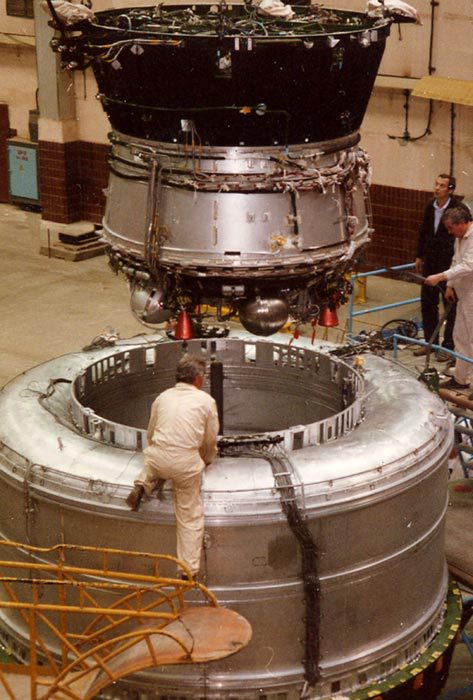
Design
Blocks of the Breeze family are distinguished by a very dense layout:

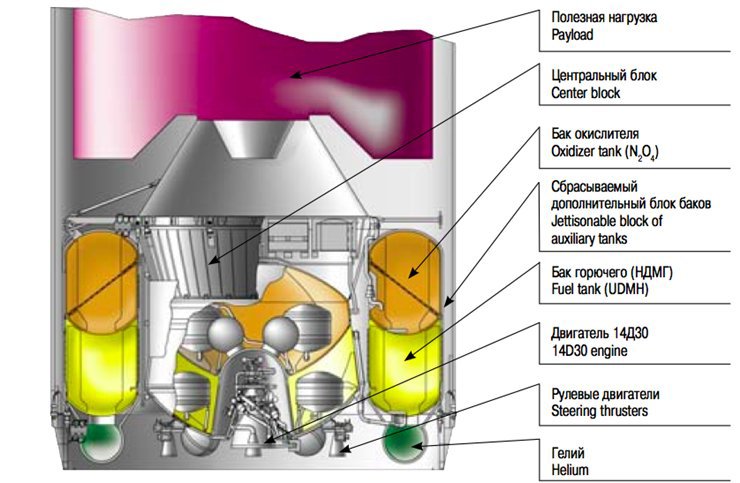
More detailed drawing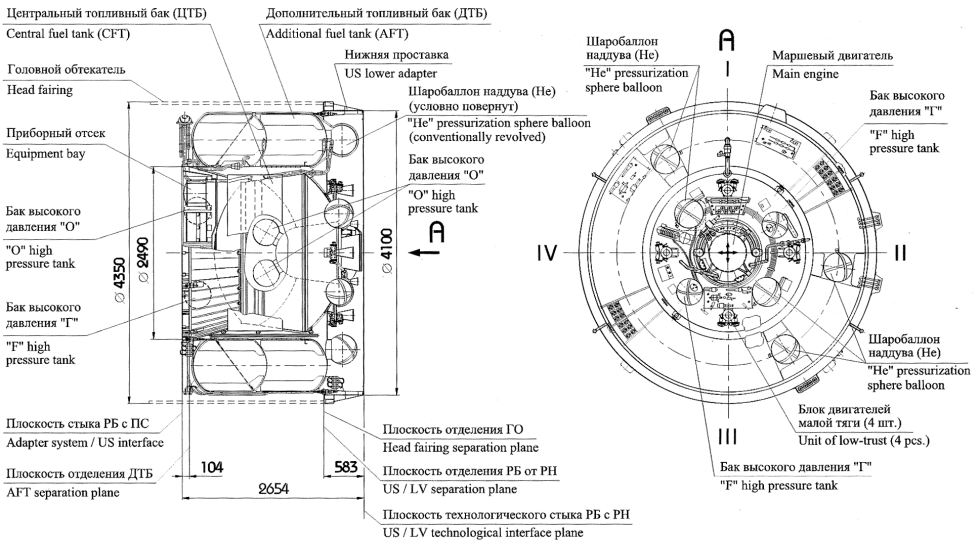

Pay attention to technical solutions:
- The engine is inside the “cup” in the tank.
- Inside the tanks there are also cylinders with pressurized helium.
- The fuel and oxidizer tanks have a common wall (due to the use of the UDMH / AT pair, this does not represent technical difficulty), there is no increase in the block length due to the inter-tank compartment
- Tanks are carriers - there are no power trusses that would require additional weight and increase the length
- Discharged tanks are in fact a half step, which, on the one hand, requires excess weight on the walls, on the other - allows you to increase the stock of characteristic speed due to dumping empty tanks.
Dense layout saves geometric dimensions and weight, but it also has its drawbacks. For example, an engine that, while working, radiates heat, is located very close to tanks and pipelines. And the combination of higher (by 1-2 degrees, within the specification) fuel temperature with higher thermal stress of the engine operation (also within the specification) led to boiling of the oxidizer, disturbance of the cooling of the THA turbine with a liquid oxidizer and disruption of its operation, which caused the accident of the Republic of Belarus during the launch of the Yamal-402 satellite in December 2012 .
The engines of the Republic of Belarus use a combination of three types of engines: propulsion C5.98 (14D30) with 2 tons of toner, four correction engines (actually, precipitation engines, ullage motors), which are turned on before starting the propulsion engine to deposit fuel to the bottom of the tanks, and twelve engines orientation 1.3 kg. The main engine has very high parameters (pressure in the combustion chamber ~ 100 atm, specific impulse 328.6 s) despite the open circuit. His "fathers" stood at the Phobos Mars stations and "grandfathers" at the lunar landing stations of the Luna-16 type. Marching engine can be guaranteed to turn on up to eight times, and the life of the unit for at least a day.
The mass of a fully filled unit is up to 22.5 tons, the payload reaches 6 tons. But the total mass of the block after separation from the third stage of the launch vehicle is slightly less than 26 tons. When placed on a geo-transfer orbit, the Republic of Belarus is not refueled, and a fully filled tank for direct output to the GSO brought up a maximum of 3.7 tons of payload. The thrust-to - weight ratio of the block is ~ 0.76. This is a lack of RB "Breeze", but small. The fact is that after separation, the RB + PN are in an open orbit, which requires an impulse to finish, and a small engine thrust leads to gravitational losses. Gravitational losses are about 1-2%, which is quite a bit. Also, long periods of engine operation increase reliability requirements. On the other hand, the main engine has a guaranteed service life of up to 3200 seconds (almost an hour!).
Little about reliability
The family of RB "Breeze" is operated very actively:
- 4 flights of "Briz-M" on "Proton-K"
- 72 flights of "Briz-M" on "Proton-M"
- 16 flights "Breeze-KM" on "Rokot"
Total 92 flights on February 16, 2014. Of these, 5 accidents occurred (I recorded a partial success with Yamal-402 as an accident) due to the Briz-M block and 2 due to the Briz-KM fault, which gives us 92% reliability. Consider the causes of accidents in more detail:
- February 28, 2006, ArabSat 4A - premature engine shutdown due to an extraneous particle trapped in a hydro turbine nozzle ( source 1 , source 2 ), a single production defect.
- March 15, 2008, AMC-14 - premature engine shutdown, destruction of the high-temperature gas pipeline ( source ), its refinement was required.
- August 18, 2011, Express AM4. Unjustifiably “narrowed” time interval of the backing of a gyro-stabilized platform, incorrect orientation ( source ), programmer's mistake.
- August 6, 2012, Telkom 3, Express MD2. Engine shutdown due to clogging of the high-pressure line ( source ), manufacturing defect.
- December 9, 2012, Yamal-402. Engine shutdown due to the failure of the THA, a combination of adverse temperature factors ( source )
- October 8, 2005, "Breeze-KM", Cryosat, non-separation of the second stage and RB, abnormal software ( source ), programmers error.
- February 1, 2011, Breeze-KM, Geo-IK2, abnormal motor impulse, presumably due to the failure of the control system, due to the lack of telemetry, it is impossible to establish the exact cause.
If we analyze the causes of accidents, then only two problems are associated with structural problems and design errors - the burnout of the pipeline and the loss of cooling of the THA. All other accidents, the cause of which is known reliably, are associated with problems of production quality and preparation for launch. This is not surprising - the space industry requires a very high quality of work, and the error even of an ordinary employee can lead to an accident. By itself, "Breeze" is not an unsuccessful design, however, it is worth noting the lack of safety margin due to the fact that to ensure the maximum characteristics of RB materials work close to the border of their physical strength.
')
We fly
It's time to go to practice - go manually to the geostationary orbit in Orbiter. For this we need:
Release Orbiter, if you have not downloaded it after reading the first post, here is the link .
Addon "Proton LV" download from here
Some theory
Of all the parameters of the orbit, here we will be interested in three parameters: the height of the pericenter (for the Earth — perigee), the height of the apocenter (for the Earth — apogee), and inclination:

- The height of the apocenter is the height of the highest point of the orbit, denoted as On.
- The height of the pericenter is the height of the lowest point of the orbit, denoted as NP.
- The inclination of the orbit is the angle between the plane of the orbit and the plane passing through the Earth's equator (in our case, the orbits around the Earth), denoted by i .
The geostationary orbit is a circular orbit with a height of the pericenter and apocenter 35,786 km above sea level and an inclination of 0 degrees. Accordingly, our task is divided into the following stages: to reach low earth orbit, raise the apocenter to 35,700 km, change the inclination to 0 degrees, raise the pericenter to 35,700 km. It is more profitable to change the orbit inclination in the apocenter, because there is less satellite speed, and, the slower the speed, the less delta-V must be applied to change it. One of the tricks of orbital mechanics is that sometimes it is more profitable to raise the apocenter much higher than the desired one, change the inclination there, and later lower the apocenter to the desired one. The costs of raising and lowering the apocenter above the desired + change in inclination may be less than the change in inclination at the height of the desired apocenter.
Flight plan
In the scenario with Briz-M, Sirius-4, a Swedish communications satellite launched in 2007, should be output. Over the past years, it has already been renamed, now it 's the Astra-4A . The plan for his launch was this:

It is clear that, when we manually enter orbit, we lose the accuracy of the automata performing the calculations of the ballistics, so our flight parameters will be with rather large errors, but this is not terrible.
Stage 1. Entering the reference orbit
Stage 1 takes time from launching the program to going into a circular orbit with a height of about 170 km and an inclination of 51 degrees (a heavy legacy of Baikonur’s latitude, when launched from the equator, it would be immediately 0 degrees).
Script Proton LV / Proton M / Proton M - Breeze M (Sirius 4)

From the loading of the simulator to the separation of the Republic of Belarus from the third stage, you can admire the views - everything is done by automation. Is it necessary to switch the focus of the camera on the rocket from the ground view (press F2 to the values from the left-top absolute direction or global frame ).
In the process of launching, I recommend switching to the “inside” view of F1 , to prepare for what awaits us:
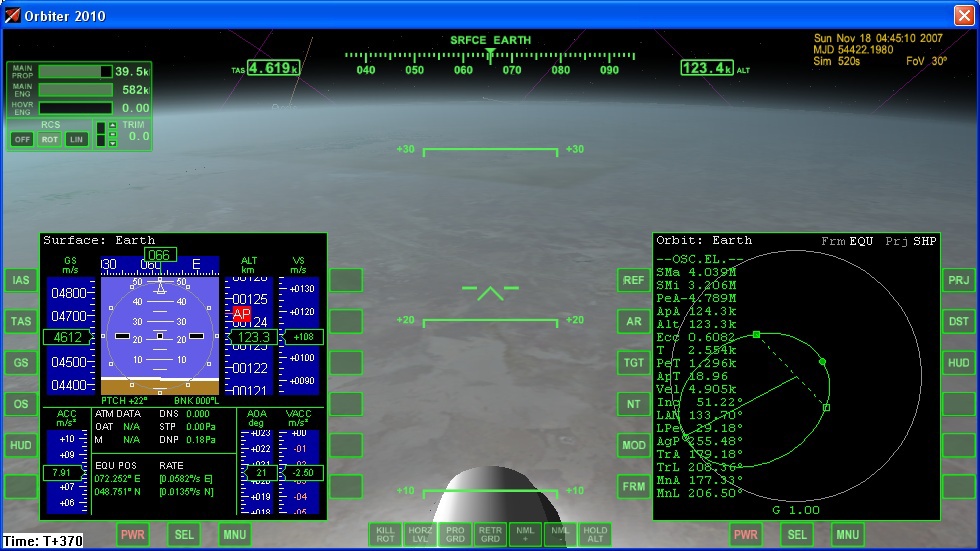
By the way, in Orbiter you can enable a pause for Ctrl-P , it may be useful to you.
A few explanations about the values of important indicators for us:
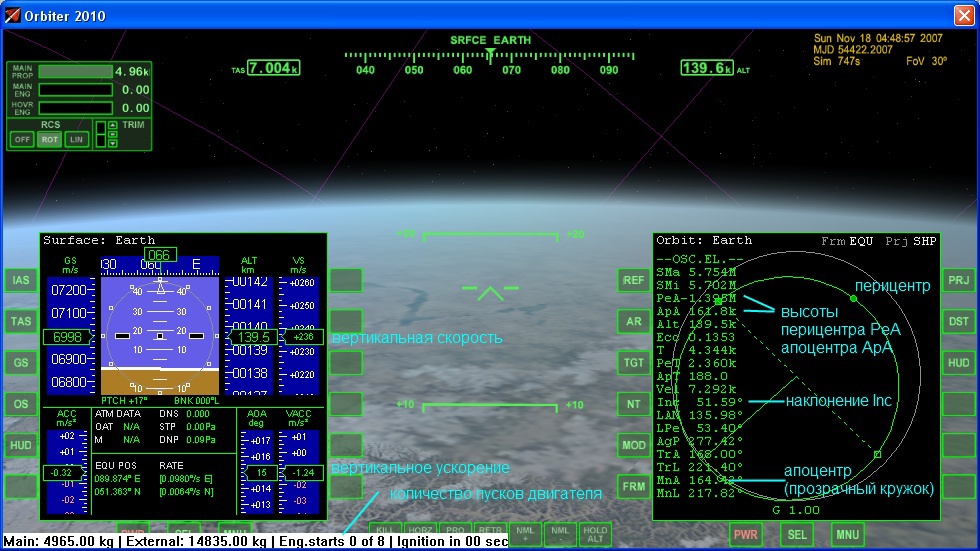
After the separation of the third stage, we find ourselves in an open orbit with the threat of falling into the Pacific if we act slowly or incorrectly. In order to avoid such a sad fate, we should go into a supporting orbit, for which we should:
- Stop the rotation of the block by pressing the button Num 5 . T.N. KillRot mode (stop rotation). After fixing the position, the mode automatically turns off.
- Toggle the back view to the front view with the C key.
- Switch the windshield indicator to orbital mode (Orbit Earth from above) by pressing the H button.
- Using the Num 2 (turn up), Num 8 (turn down), Num 1 (turn left), Num 3 (turn right), Num 4 (roll to the left), Num 6 (roll to the right) and Num 5 (stop rotation) turn block in the direction of motion with a pitch angle of about 22 degrees and fix the position.
- Start the engine start procedure (first Num + , then, without releasing, Ctrl ).
If you do it right, the picture will look something like this:
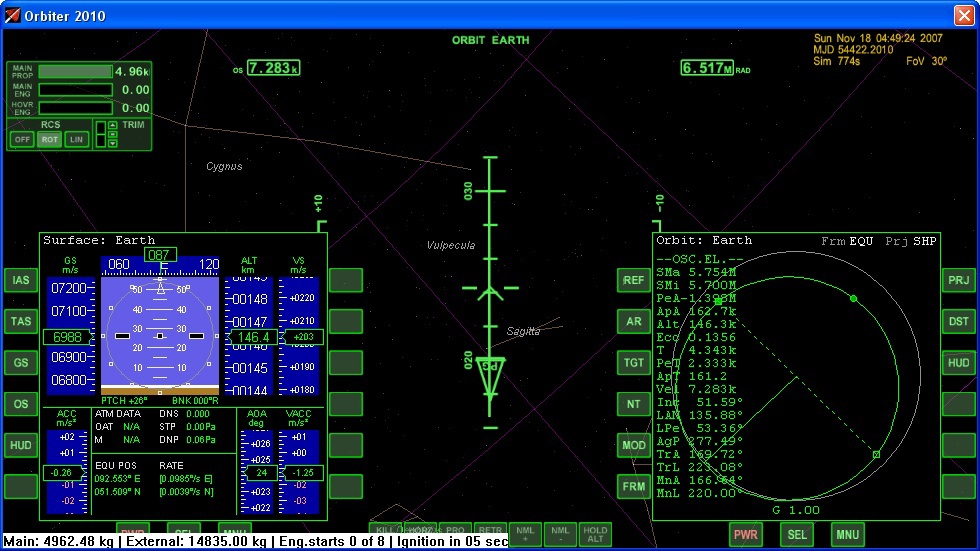
After turning on the engine:
- Create a rotation that will fix the pitch angle (a pair of clicks Num 8 and the angle will not change noticeably).
- In the process of engine operation, keep the pitch angle in the range of 25-30 degrees.
- When the values of the pericenter and apocenter are in the area of 160-170 km, turn off the engine with the Num button * .
If everything went well, there would be something like:

The most nervous part is over, we are in orbit, there is nowhere to fall.
Stage 2. Entering an intermediate orbit
Due to the low thrust-weight ratio, the apocenter has to be lifted to 35,700 km in two stages. The first stage is an exit to an intermediate orbit with an apocenter of ~ 5000 km. The specificity of the problem is that it is necessary to accelerate so that the apocenter is not away from the equator, i.e. it is necessary to accelerate symmetrically relative to the equator. The projection of the map to the Earth’s map will help us with this:
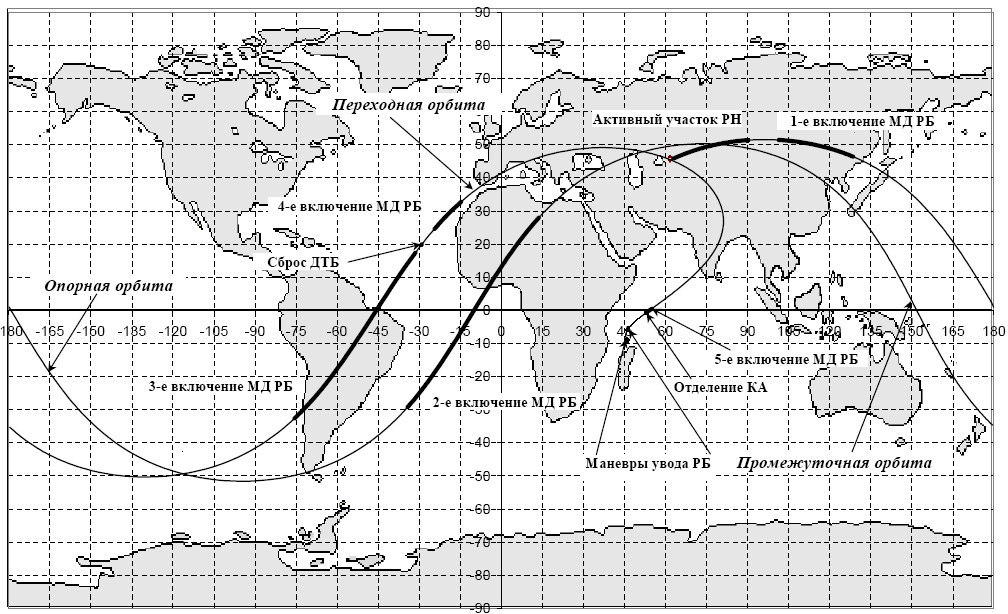
The picture for the recently launched Turksat 4A, but it does not matter.
Preparation for entering the intermediate orbit:
- Switch the left multi-function display to map mode ( Left Shift F1 , Left Shift M ).
- With the help of the acceleration of time (accelerate 10 times R , slow down 10 times T ) wait until the flight over South America.
- Orient the block to the position along the orbital velocity vector (with the nose in the direction of motion). You can press the [ button to make it automatic, but here it is not very effective, it is better to manually.
- Give the block a spin down to maintain the orientation along the orbital velocity vector.
It should turn out something like:

In the area of latitude 27 degrees, it is necessary to turn on the engine, and, keeping the orientation along the orbital velocity vector, fly until the apocenter reaches 5000 km. You can include an acceleration of 10x. Upon reaching the apocentre 5000 km, turn off the engine.
Music, in my opinion, is very suitable for acceleration in orbit
If everything went well, we get something like:

Stage 3. Entering the transition orbit
Very similar to stage 2:
- Using the acceleration of time (accelerate 10 times R , slow down 10 times T , you can safely accelerate to 100x, I don’t advise 1000x) to wait until flying over South America.
- Orient the block to the position along the orbital velocity vector (with the nose in the direction of motion).
- Give the block a spin down to maintain the orientation along the orbital velocity vector.
- In the area of latitude 27 degrees it is necessary to turn on the engine, and, keeping the stabilization along the orbital velocity vector, fly until the apocenter reaches 35700 km. You can include an acceleration of 10x.
- When fuel runs out of the external fuel tank, reset it by pressing D. Start the engine again.
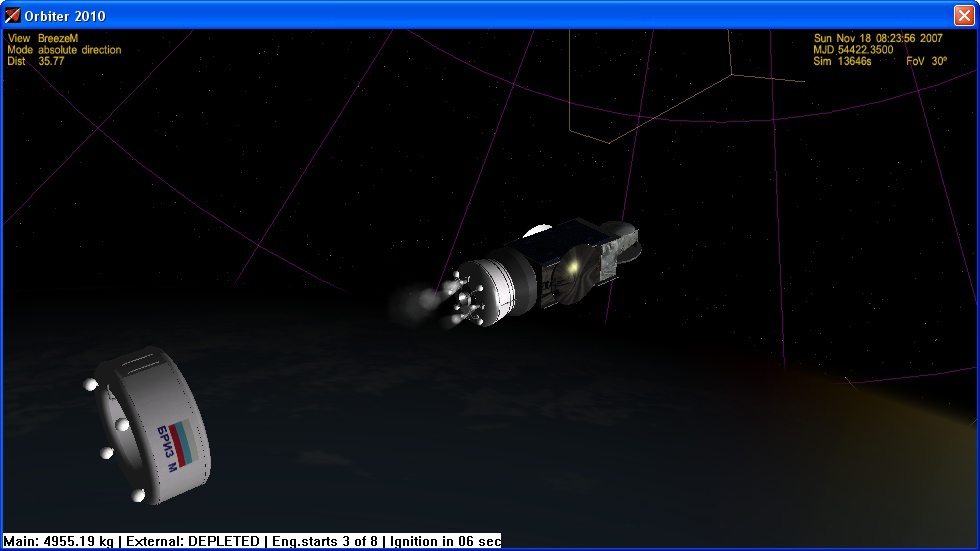
Reset fuel tank, visible engine deposition
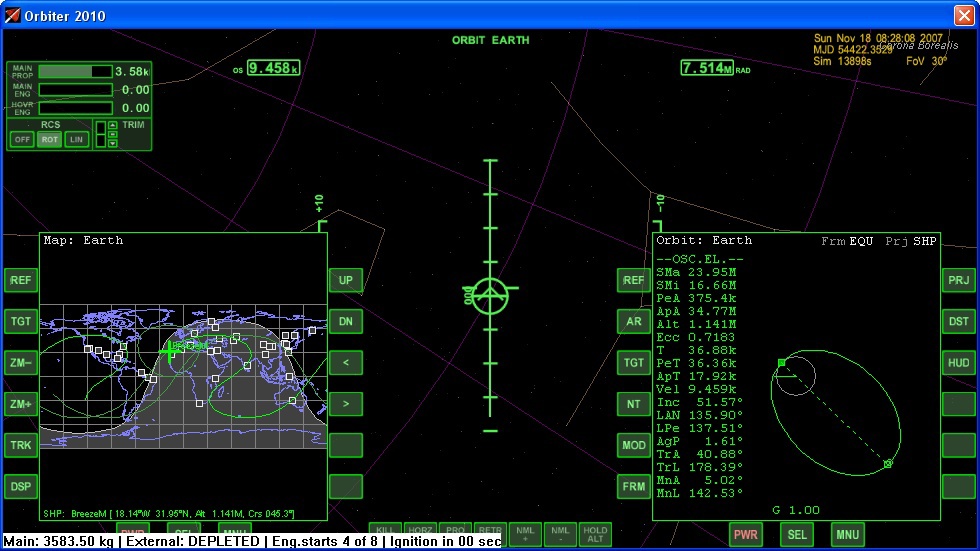
Result. Please note, I hurried to turn off the engine, apocenter 34.7 thousand km. It's not scary, for the purity of the experiment, let's leave it.
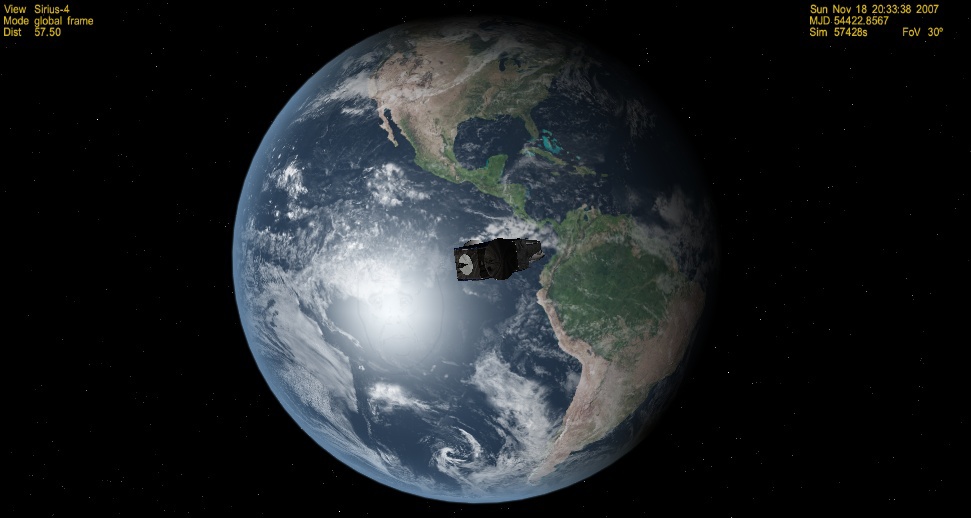
Beautiful view
Stage 4. Changing the orbit inclination
If you did everything with small errors, then the apocenter will be near the equator. Procedure:
- Accelerating time to 1000x wait for the approach to the equator.
- Orient the block perpendicular to the flight, upwards, as viewed from the outer side of the orbit. For this, the automatic mode Nml + is suitable, which is activated by pressing a button ; (she is)
- Turn on the engine.
- If after the maneuver to zero the inclination, fuel remains, you can spend it on raising the pericenter.
- After finishing the fuel with button J, separate the satellite, open its solar panels and antennas Alt-A , Alt-S
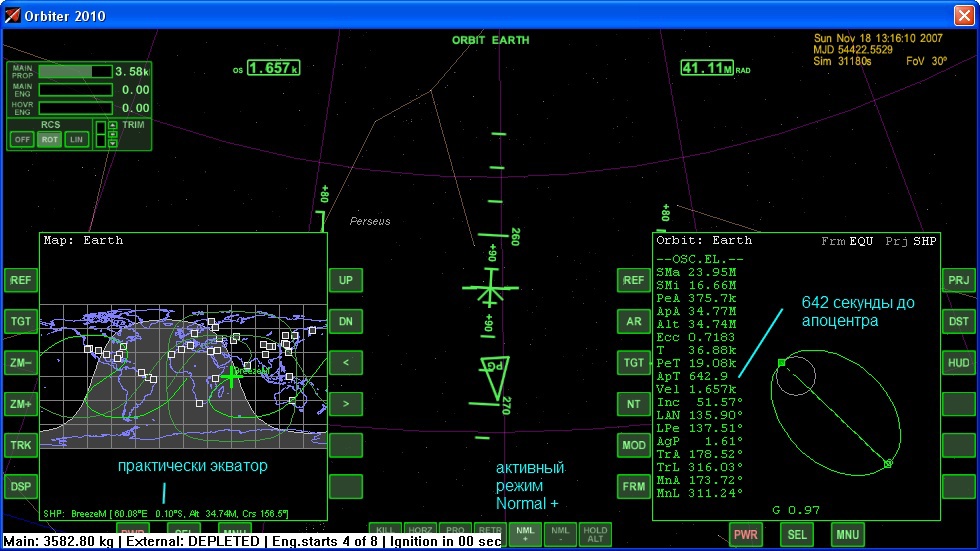
Start position before maneuver
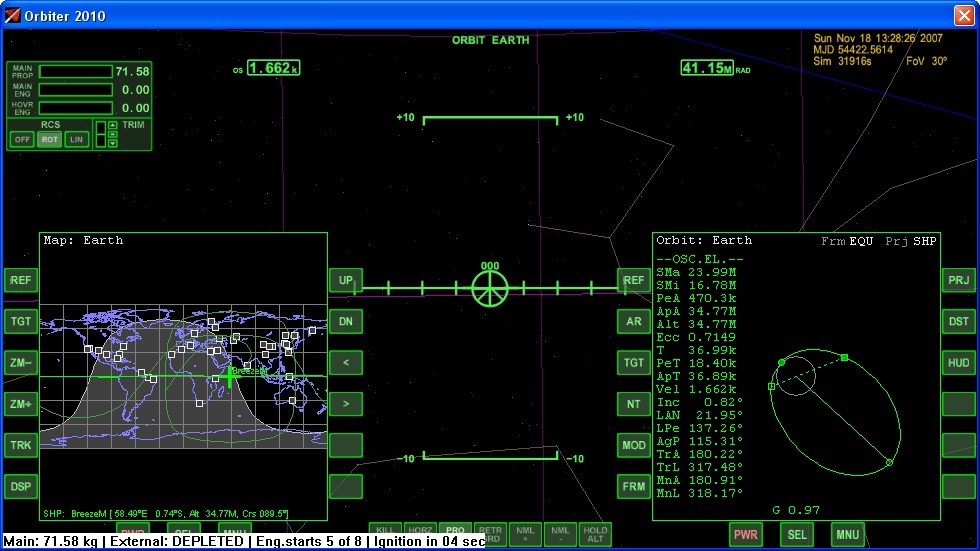
After maneuver
Stage 5. Independent launch of a satellite in the GSO
The satellite has an engine with which you can raise the pericenter. To do this, in the area of the apocenter, we orient the satellite along the orbital velocity vector and turn on the engine. The engine is weak, must be repeated several times. If you do everything right, the satellite will still have about 20% of the fuel to correct for disturbances of the orbit. In reality, the impact of the Moon and other factors leads to the fact that the satellite orbit is distorted, and it is necessary to spend fuel to maintain the required parameters.
If everything worked out for you, the picture will be something like:
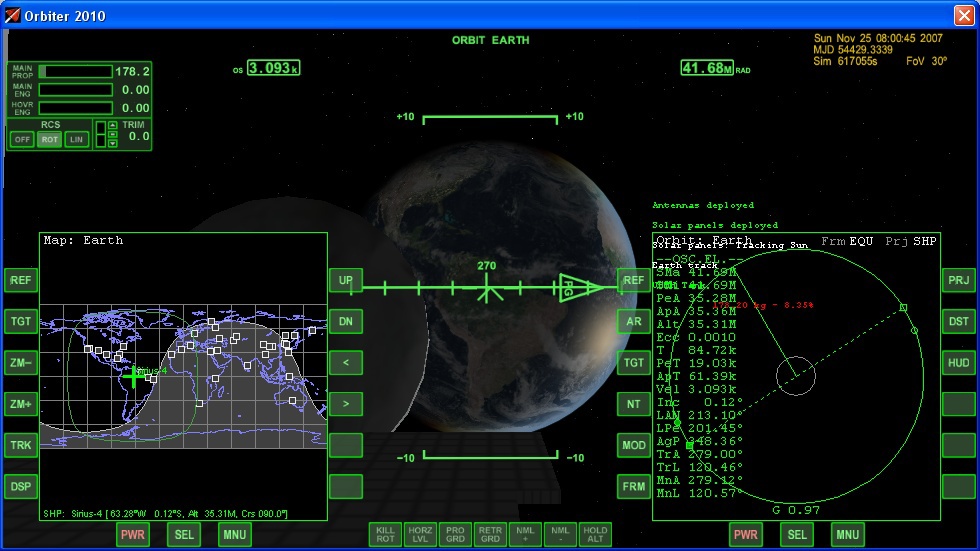
Well, a small illustration of the fact that a satellite in the GSO is located above one place on Earth:
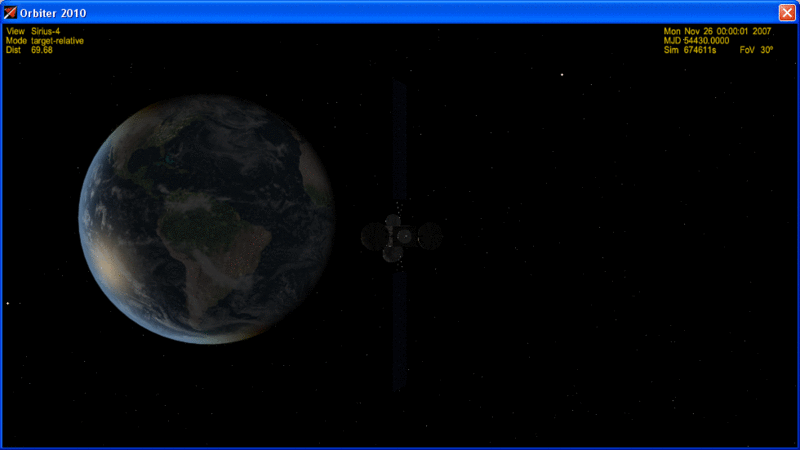
Scheme start Turksat 4A for comparison



UPD : after consulting with aykSpace , I replaced the ugly homemade tracing from Orbiter Prograde / Retrograde with a real-life term “by / against the orbital velocity vector”
UPD2 : I have been contacted by a payload adaptation specialist for Briza-M. Khrunicheva added a couple of comments to the article:
- On the suborbital trajectory (the beginning of stage 1), in reality, it is not 28 tons that are displayed, but a little less than 26, because the RBs are not fully charged.
- Gravitational losses are only 1-2%
Source: https://habr.com/ru/post/212735/
All Articles